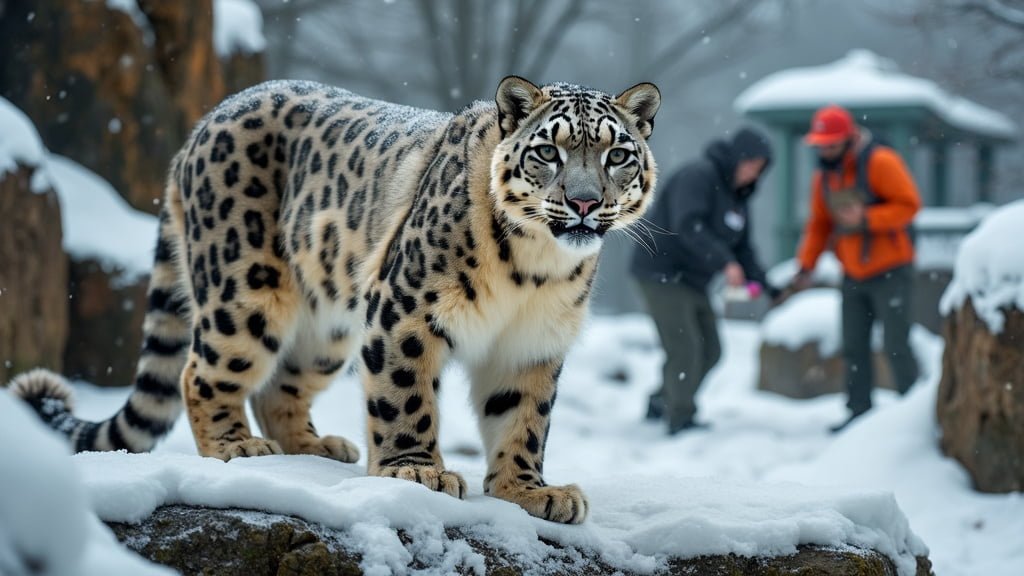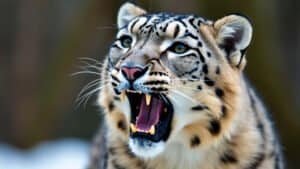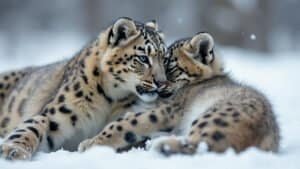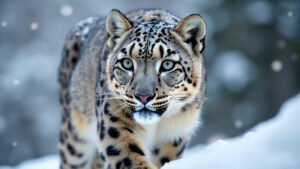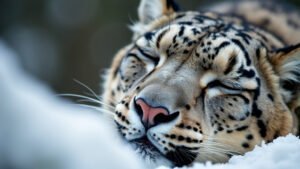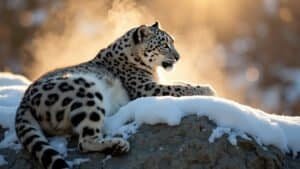Introduction
Zoos play a vital role in the conservation of snow leopards, an endangered species facing threats from habitat loss, poaching, and climate change
This article explores how zoos contribute to the survival of snow leopards through captive breeding, scientific research, public education, and partnerships with global conservation organizations. We will examine the importance of breeding programs, the role of research in understanding and protecting these elusive cats, and how zoos raise awareness among the public
Additionally, the challenges zoos face in these efforts and their collaborations with international conservation bodies will be discussed, highlighting the impact of zoos on snow leopard conservation
How Zoos Contribute to Snow Leopard Breeding Programs
Zoos play a crucial role in snow leopard conservation by establishing and managing breeding programs aimed at ensuring the species’ survival. These programs are designed to maintain genetic diversity and prevent the extinction of snow leopards, which face numerous threats in the wild
Through coordinated efforts, zoos worldwide are working together to create viable, self-sustaining populations in captivity that can potentially be reintroduced into their natural habitats
The Importance of Breeding Programs
Captive breeding programs are a key component of the overall snow leopard conservation strategy. Given the limited and declining numbers of snow leopards in the wild—estimated to be between 4,000 and 6,500 according to the Snow Leopard Trust—these programs provide a safety net for the species
By maintaining a healthy population in zoos, conservationists ensure that there is a genetically diverse group of snow leopards, reducing the risk of inbreeding and genetic bottlenecks, which can lead to a weakened gene pool
The International Union for Conservation of Nature (IUCN) supports captive breeding as a means of safeguarding endangered species like the snow leopard. These efforts are part of broader species survival plans (SSPs), where zoos coordinate globally to exchange animals, genetic material, and information to maintain healthy populations
The Association of Zoos and Aquariums (AZA) oversees many of these programs, working with facilities across the globe to optimize breeding efforts
Captive Breeding Successes
There have been significant successes in snow leopard captive breeding programs, with zoos producing numerous healthy offspring that contribute to the global population
Institutions like the Bronx Zoo and the San Diego Zoo have been particularly successful in breeding snow leopards, providing detailed care and attention to the reproductive needs of these animals. One example is the Global Species Management Plan (GSMP), which facilitates the exchange of animals between zoos to avoid inbreeding and to maximize genetic diversity
In 2021, for example, the Woodland Park Zoo in Seattle successfully welcomed the birth of two snow leopard cubs, a testament to the effectiveness of these breeding programs
Such successes are not only important for population numbers but also for studying snow leopard behavior and reproductive biology, which can inform conservation practices in the wild
Genetic Diversity and Management
One of the primary goals of zoo breeding programs is to maintain and enhance the genetic diversity of the snow leopard population. Genetic diversity is critical for the species’ long-term survival, as it enables populations to better adapt to environmental changes and resist diseases
Zoos use advanced genetic tools to monitor the genetic makeup of their snow leopard populations. This ensures that breeding decisions are made based on genetic compatibility rather than proximity or convenience
Modern technology, such as DNA analysis, plays a crucial role in these efforts. Researchers can identify genetic markers that help them pair animals in ways that maximize genetic health
The Frozen Zoo project, for instance, collects and stores genetic material (e.g., sperm and eggs) from snow leopards, allowing zoos to use assisted reproductive techniques like artificial insemination, thereby improving breeding outcomes and protecting the species’ genetic legacy
Breeding Program Challenges
While zoo breeding programs have been successful, they are not without challenges. One major hurdle is the natural solitary behavior of snow leopards, which can complicate breeding efforts
Snow leopards are territorial and typically come together only for mating. This means that zoos must carefully manage the introduction of breeding pairs to avoid conflict and ensure a successful mating
Another challenge is maintaining the health of snow leopards in captivity. While they are well-cared for in zoo environments, they may not develop the same survival skills as their wild counterparts. Zoos must find a balance between providing a safe, controlled environment and allowing for natural behaviors that can help with future reintroduction efforts
In addition, some critics argue that keeping snow leopards in captivity may not be the best long-term solution for species conservation. They claim that resources would be better spent on protecting habitats and reducing poaching threats in the wild
However, zoos counter that their breeding programs provide a critical lifeline for the species, particularly in light of ongoing habitat destruction and climate change that continue to threaten wild populations
Research Conducted by Zoos for Snow Leopard Conservation
Zoos contribute significantly to snow leopard conservation through extensive research. This research ranges from studying snow leopard behavior and health in captivity to contributing valuable genetic data that informs broader conservation strategies
Zoo-based research helps scientists better understand the needs of snow leopards, both in captivity and in the wild, and supports efforts to preserve their populations for future generations
Behavioral Studies in Captivity
Zoos provide a unique opportunity to observe snow leopards up close, allowing researchers to study their behaviors in ways that are not possible in the wild. Behavioral studies in zoos focus on several key areas, including social interactions, mating behaviors, and hunting instincts
By understanding how snow leopards behave in controlled environments, researchers can identify patterns that may help in managing their conservation both in captivity and in their natural habitats
For example, zoos like the Denver Zoo and San Diego Zoo have conducted studies on snow leopard territoriality and their response to enrichment activities designed to stimulate natural behaviors
These enrichment activities, such as introducing scent markers or providing complex environments with varied terrain, encourage behaviors that mimic what snow leopards would experience in the wild
Such research not only enhances the well-being of snow leopards in captivity but also provides insights into how they might respond to environmental changes in the wild
Genetic Research and DNA Analysis
One of the most crucial contributions zoos make to snow leopard conservation is through genetic research. Genetic analysis is vital for understanding the overall health of the snow leopard population, especially in ensuring genetic diversity within breeding programs
Zoos collaborate with geneticists and universities to map the genomes of snow leopards and identify important genetic markers
For example, research conducted at the Smithsonian Conservation Biology Institute has helped develop comprehensive genetic profiles of captive snow leopards. These profiles guide breeding decisions to prevent inbreeding and genetic bottlenecks
Through advanced techniques like DNA sequencing and genome mapping, researchers can identify genetic vulnerabilities in the population, which informs both captive breeding and conservation strategies in the wild
The development of cryobanking, where genetic material from snow leopards is preserved, has also been an essential part of zoo research
Cryopreservation allows zoos to store genetic material for future breeding programs, ensuring that even if individual animals cannot reproduce naturally, their genetic contributions are not lost
Health and Disease Research
Zoos are also at the forefront of studying snow leopard health, particularly in identifying and managing diseases that can affect both captive and wild populations
Veterinary teams in zoos constantly monitor the health of their snow leopard residents, conducting regular exams, blood tests, and screenings for common ailments. This proactive approach ensures that any health issues are detected early, which improves the overall survival rate of snow leopards in captivity
Furthermore, zoos collaborate with researchers to study diseases that may threaten snow leopards in the wild. For example, parasites and infections common in mountainous regions can severely impact wild snow leopard populations
Research from zoos, such as studies published by the Wildlife Health Center at the University of California, Davis, contributes to developing treatments and vaccines for these diseases, which are then applied in the wild
Contribution to Wild Conservation
Zoo-based research doesn’t just benefit snow leopards in captivity; it also plays a crucial role in informing conservation strategies for wild populations
Studies on snow leopard genetics, health, and behavior help conservationists make informed decisions about protecting and managing wild populations. This data is shared with international conservation organizations like Panthera and the Snow Leopard Trust, which work directly with local communities and governments in the snow leopard’s natural habitat
For instance, research on snow leopard movement and behavior in captivity has been used to inform the design of wildlife corridors and protected areas in Central Asia
By understanding how snow leopards navigate their environments in zoos, conservationists can create more effective strategies to protect their habitats and mitigate human-wildlife conflict in the wild
Zoos’ Role in Public Education and Awareness
Public education is one of the most impactful ways that zoos contribute to snow leopard conservation. By informing and engaging visitors, zoos raise awareness about the threats facing snow leopards and inspire support for conservation efforts
Through educational programs, interactive exhibits, and outreach initiatives, zoos help build a deeper connection between people and wildlife, fostering a conservation mindset that can lead to real-world action
Educational Outreach and Programs
Zoos across the United States play a significant role in educating the public about snow leopards through well-structured outreach and educational programs
These programs target a wide audience, from young children to adults, encouraging an understanding of snow leopard biology, ecology, and conservation needs. Zoos like the Central Park Zoo and the Cincinnati Zoo offer specialized programs that focus on the importance of protecting endangered species like the snow leopard
For instance, zoos organize “keeper talks” where zoo staff share in-depth knowledge about snow leopards, covering topics like their behavior, diet, and the conservation challenges they face
These talks often highlight how habitat destruction, poaching, and climate change threaten snow leopard populations, emphasizing the importance of conservation initiatives
Additionally, many zoos partner with schools and community organizations to deliver conservation curricula that focus on the snow leopard and its habitat. Programs like the “Snow Leopard Trust’s Education for Conservation” are designed to not only teach children about the importance of these animals but also to empower them to become conservation advocates within their communities
Engaging Visitors in Conservation Efforts
Zoos have developed innovative ways to engage visitors in direct conservation actions. Many zoos now incorporate interactive exhibits that allow visitors to see snow leopards in environments that simulate their natural habitats
These immersive experiences give visitors a better understanding of the challenges snow leopards face in the wild and how their survival is tied to the protection of high-altitude ecosystems in Central Asia
Beyond just observing the animals, visitors are often invited to participate in campaigns that support snow leopard conservation. For example, some zoos offer the opportunity to “adopt” a snow leopard, where proceeds from symbolic adoptions go directly to conservation projects like anti-poaching patrols or habitat restoration
Other initiatives encourage zoo visitors to donate to organizations like the Snow Leopard Trust, which works closely with local communities in snow leopard habitats to reduce human-wildlife conflict
Some zoos also hold annual conservation events like the “Big Cat Conservation Day” to draw attention to the plight of big cats, including snow leopards. During these events, visitors are educated about global conservation efforts and how they can contribute through donations or volunteer work
Raising Awareness of Snow Leopard Challenges
Zoos are instrumental in raising awareness about the specific challenges snow leopards face in the wild. By showcasing snow leopards and their stories, zoos bring the conservation crisis to a wider audience, many of whom may be unaware of the threats these animals encounter
Educational signage near exhibits often details the snow leopard’s status as an endangered species, along with information about their shrinking habitat, illegal hunting for pelts, and the impact of climate change
The Smithsonian’s National Zoo in Washington, D.C., for instance, has played a major role in increasing public knowledge of snow leopards through its interactive exhibits and educational materials
These efforts highlight the complexity of snow leopard conservation, from the geopolitical challenges of protecting habitats in multiple countries to the on-the-ground efforts of tracking and monitoring wild populations
In many zoos, digital displays and short films are used to show how conservationists track snow leopards in the wild using GPS collars and camera traps. These technologies allow scientists to monitor snow leopard populations and movement patterns, gathering essential data to inform future conservation strategies
Sharing this information with the public helps make conservation more tangible and real, demonstrating the importance of sustained support for global efforts to protect snow leopards
How Public Support Affects Conservation
Public support is crucial for the success of snow leopard conservation programs, and zoos play a key role in garnering that support
By informing visitors about the challenges faced by snow leopards, zoos can inspire people to take action—whether that means making a donation, supporting sustainable tourism, or advocating for wildlife protection policies
The direct connection between the public and conservation efforts can be seen in the growing interest in wildlife-friendly products, such as handicrafts made by local communities in snow leopard habitats, sold at zoo gift shops, with proceeds going to conservation projects
Additionally, the financial support that zoos receive from public donations helps fund important research and in-situ conservation projects. Many of these funds are channeled to partner organizations working directly in snow leopard habitats, ensuring that efforts to protect the species extend beyond the zoo walls
Partnerships Between Zoos and Global Conservation Organizations
Zoos play an essential role in snow leopard conservation through partnerships with global conservation organizations. By collaborating with international entities, zoos help fund research, protect natural habitats, and contribute to the broader goal of preserving snow leopard populations in the wild
These partnerships allow for the exchange of knowledge, resources, and expertise, ultimately strengthening conservation efforts both inside and outside of zoos
Collaborative Conservation Initiatives
Zoos frequently collaborate with organizations like the Snow Leopard Trust, Panthera, and the World Wildlife Fund (WWF) to advance snow leopard conservation efforts
These partnerships are crucial in addressing the challenges of snow leopard protection, especially in the remote and rugged mountain ranges of Central Asia, where the species is most vulnerable
One of the most notable collaborations is the Global Snow Leopard & Ecosystem Protection Program (GSLEP), which involves 12 snow leopard range countries, including China, India, and Mongolia
Zoos are key contributors to GSLEP, providing financial and technical support for conservation programs aimed at preserving snow leopard habitats and promoting community-based initiatives that reduce human-wildlife conflict
The Snow Leopard Trust, one of the most prominent conservation organizations focused on this species, regularly works with zoos to support its projects in the field
Zoos like the Woodland Park Zoo in Seattle and the Bronx Zoo in New York are long-time partners of the Snow Leopard Trust, helping fund anti-poaching patrols, livestock insurance programs, and educational outreach in local communities
Sharing Resources and Knowledge
Zoos are valuable partners in conservation due to their capacity to share resources, research, and expertise
This collaborative spirit extends to global conservation efforts where zoos contribute by providing data from captive populations, funding field research, and offering technical expertise in veterinary care, genetics, and animal husbandry
One example of this knowledge sharing is the Snow Leopard Network, which connects over 600 conservationists, scientists, and zoo professionals working to protect snow leopards globally. This network enables zoos to share best practices, research findings, and success stories from captive breeding and field conservation
By pooling resources and expertise, zoos and conservation organizations can more effectively tackle the complex challenges of snow leopard conservation
Zoos also contribute valuable data on the genetics, health, and behavior of snow leopards. This information is essential for creating effective conservation strategies that can be applied in both captive and wild settings
For instance, genetic research conducted in zoos helps inform decisions about reintroduction programs, ensuring that captive-bred snow leopards are genetically diverse and healthy enough to survive in the wild
Supporting In-Situ Conservation
In addition to their work within zoos, many institutions provide direct financial and logistical support for in-situ (on-site) conservation efforts in snow leopard habitats. Zoos fund projects aimed at protecting snow leopard ecosystems, reducing poaching, and promoting sustainable livelihoods for local communities that share their environment with snow leopards
For example, the Snow Leopard Trust’s livestock insurance programs, which compensate herders for livestock lost to snow leopard predation, are supported by zoos like the Minnesota Zoo and the Houston Zoo. These programs help reduce retaliatory killings of snow leopards, a major threat to the species in the wild
Zoos also support the installation of camera traps and GPS collaring programs, which are crucial for monitoring snow leopard populations in the wild
These technologies provide critical data on snow leopard behavior, range, and population dynamics, helping conservationists design more effective strategies to protect these elusive animals. The support zoos provide for these initiatives is often vital to their success, as in-situ conservation requires substantial resources
Case Studies of Successful Collaborations
Several successful case studies highlight how zoo partnerships have positively impacted snow leopard conservation. One such example is the partnership between the Bronx Zoo and Panthera’s Snow Leopard Program
Through this collaboration, the Bronx Zoo has helped fund the training of local conservation teams to monitor snow leopards in the wild using camera traps and GPS collars. This partnership has been instrumental in expanding the monitoring network across snow leopard habitats in Mongolia and Kyrgyzstan
Another example is the collaboration between the Snow Leopard Trust and the Zurich Zoo. Together, they have worked on community-based conservation programs that engage local herders in protecting snow leopards by offering alternative income sources, such as selling handicrafts made from sustainably sourced materials
These initiatives have reduced human-snow leopard conflict while promoting wildlife-friendly practices that benefit both people and animals
The shared success of these initiatives demonstrates the power of collaboration between zoos and conservation organizations. By pooling resources, expertise, and data, zoos can extend their reach beyond captive populations and make a meaningful impact on the survival of snow leopards in the wild
Challenges Zoos Face in Snow Leopard Conservation
While zoos contribute significantly to snow leopard conservation, they face numerous challenges that complicate their efforts to protect and sustain these endangered animals
From financial limitations to ethical dilemmas, zoos must navigate various obstacles to ensure that their conservation programs are both effective and aligned with broader wildlife protection goals
Funding and Resource Constraints
One of the most significant challenges zoos face in snow leopard conservation is the ongoing struggle for sufficient funding and resources
Maintaining snow leopards in captivity, supporting breeding programs, and funding in-situ conservation projects require substantial financial investments. Zoos depend heavily on public donations, government grants, and partnerships with conservation organizations to keep these programs running
However, the cost of caring for snow leopards in zoos—providing appropriate habitats, veterinary care, and dietary needs—can be prohibitively expensive
Additionally, the global nature of snow leopard conservation means that zoos must also invest in international partnerships and fieldwork, which requires logistical support and funding for on-the-ground conservation teams
For instance, supporting anti-poaching patrols or creating protected habitats in countries like Mongolia or Kyrgyzstan involves significant financial and operational commitments
Many zoos face difficult decisions about how to allocate their limited resources, often balancing the needs of multiple endangered species. While snow leopard conservation is a priority, zoos must constantly weigh this against other competing demands for funding and attention
Ethical Considerations in Captive Breeding
Captive breeding of snow leopards, while crucial for species preservation, raises ethical questions that zoos must address. One of the primary concerns is whether keeping snow leopards in captivity is the most humane and effective way to ensure their survival
Snow leopards, like many big cats, are naturally solitary and highly territorial animals, and their behavior in captivity can differ significantly from their behavior in the wild. Zoos must carefully manage the stress levels, space needs, and psychological well-being of snow leopards to avoid behavioral problems such as pacing, depression, or aggression
Some critics argue that captive breeding programs may divert attention and resources away from habitat protection and efforts to reduce poaching in the wild
This raises the ethical dilemma of whether the emphasis should be placed on keeping animals in captivity or focusing entirely on protecting their natural habitats. Zoos must balance these concerns by ensuring that captive breeding programs are tied to broader conservation strategies that aim to restore and protect wild populations
Additionally, there are ethical questions about the long-term fate of captive-bred snow leopards. While breeding programs aim to preserve the species, there is no guarantee that zoo-born snow leopards can be successfully reintroduced into the wild
Concerns about their ability to adapt to wild environments, hunt for food, and avoid human conflicts complicate decisions about how best to use captive populations for conservation
Balancing Captive Care with Conservation Goals
Zoos must find a balance between providing the best possible care for snow leopards in captivity and contributing to global conservation goals. Maintaining high standards of care for snow leopards in zoos is essential, but this often requires extensive resources, staff, and specialized knowledge
Zoos need to provide enclosures that mimic natural habitats, offer enrichment activities to stimulate natural behaviors, and manage breeding programs that avoid genetic issues like inbreeding
At the same time, zoos are expected to contribute to conservation efforts that extend beyond the zoo walls, such as supporting field research, habitat protection, and community-based conservation programs
Finding the right balance between caring for captive animals and investing in conservation projects in snow leopard range countries can be challenging, particularly when financial and logistical constraints limit the scope of what zoos can achieve
Moreover, zoos must constantly adapt to new research findings and changing conservation priorities. For example, as more is learned about snow leopard genetics and population dynamics, zoos must adjust their breeding programs accordingly
This requires ongoing collaboration with geneticists, wildlife biologists, and conservation organizations to ensure that zoo efforts are aligned with the latest scientific knowledge and conservation best practices
Addressing Public Criticism
Zoos often face public criticism regarding the ethics of keeping animals in captivity, and snow leopards are no exception. Some animal rights advocates argue that wild animals should not be kept in zoos under any circumstances, regardless of the conservation benefits
These critics claim that zoos, by confining animals in artificial environments, deprive them of the opportunity to engage in their natural behaviors and live in their native habitats
In response to this criticism, many zoos have made efforts to improve the living conditions of their animals, creating larger, more naturalistic enclosures and implementing enrichment programs designed to encourage natural behaviors like stalking, hunting, and marking territory
Despite these improvements, the debate over the role of zoos in conservation continues, with some questioning whether captive breeding programs genuinely benefit endangered species or serve more as a public relations tool for zoos
Public education and transparency are essential in addressing these concerns. Zoos must communicate the importance of their conservation programs, including the role that captive breeding plays in preventing extinction
Additionally, by partnering with reputable conservation organizations and demonstrating tangible contributions to in-situ conservation, zoos can build trust with the public and counter criticism that their efforts are solely focused on entertainment
Conclusion
Zoos play an integral role in snow leopard conservation, contributing to the species’ survival through a combination of breeding programs, scientific research, public education, and partnerships with global conservation organizations
Their efforts in maintaining genetic diversity and studying snow leopard health and behavior help to sustain populations that can serve as a genetic reservoir for the species. Furthermore, zoos’ educational outreach raises public awareness about the threats snow leopards face, engaging people in direct conservation efforts
Despite these contributions, zoos face challenges, including ethical concerns over captive breeding, limited funding, and the difficulties of balancing captive care with broader conservation goals
Nevertheless, by collaborating with international organizations and supporting in-situ conservation initiatives, zoos extend their impact beyond their walls, ensuring they remain a vital part of the global effort to protect snow leopards in the wild. As snow leopard populations continue to be threatened, the role of zoos in safeguarding their future remains critical
